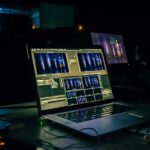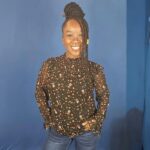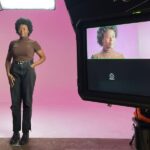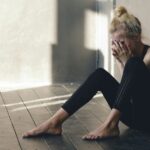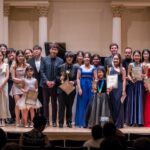Born in Beijing and now based in New York, Wenjue Lu is an unorthodox fashion designer unbounded by the realm of fashion. Wenjue combines the authentic traditional art, while retaining its unique historical and cultural significance, with the aesthetic of contemporary art driven by emotive expressions to establish an artistic collective that defies singular definition— focusing simultaneously and inter-sectionally on slow fashion, modern art, exhibitions, and cultural workshops, she initiated her eponymous label(Wenjüe Lu) in 2020 seeking to recover what is being overlooked by this fast-paced time. Wenjue marries her unconventional way of aestheticizing traditional Japanese culture while showcasing the complexity and intricacy of Sashiko, a traditional Japanese fabric mending technique that Wenjue aims to represent, interpret, and educate.
Wenjue studied and obtained her undergraduate degree at Parsons School of Design. Insisting on design and craft on a hands-on basis, she focuses on the possibilities of the naturally-colored fabric, especially on the different shades and textures of white, while infusing her ongoing exploration of her life philosophy into her artistic and cultural creations.
Some mushrooms floating, some fishes flying, some cacti on beach sand, some flowers in the air… a surreal and dreamy scenery was brought to life by Wenjue in her solo exhibition, titled “Poetic Transfigurations”, which opened on February 19th and lasted until March 6th in Chinatown, New York City.
Ranging from soft sculpture, textile art, clothing, to still objects, furniture, and more, Wenjue’s selected body of artworks serves as the blending of words and rhetorical devices in poetry which took over the LATITUDE Gallery space located on Bayard Street. Within the dreamscape carved out with her unique natural colored aesthetic, Wenjue’s works seek to resonate with its viewers’ capability for extracting elegance from the disguised simplicity, using fabrics as her language and various techniques as her rhetorical devices in poetry, filtered through Wenjue’s emphasis on hands-on craftsmanship and natural materials.
Since 2021, Wenjue has been relentlessly hosting cultural workshops instructing attendees throughout New York City on the practice of Sashiko, a traditional Japanese folk hand-stitching technique that dates back to the Edo period(1603 – 1868). Sashiko came from everyday life: Developed in the farming communities in Japan, Sashiko was born from the necessity of mending and patching garments, beddings, and household items. Wenjue explains to us that survival necessity demanded that these items be recycled for as long as possible in the past. Women mended and strengthen damaged and old garments for men during the winter. The technique gradually evolved to account for aesthetic purposes while remaining pragmatic. Different from other popular hand-stitching techniques, practicing Sashiko requires one to adopt distinct sewing gestures with a special Sashiko thimble and needle. The unusual gesture arose from the historical need to efficiently mend garments. The process of Sashiko is equally essential to its outcome, together they mark the respectableness and preciousness of the traditional technique.
Sashiko embodies the philosophies of repairing, mending, reinforcing, and decorating. Wenjue believes the best way to present Sashiko, a culture emblematic of the process of life, is to show the people where and how will this culture manifest in their lives. In Wenjue’s words: “It conveys a spirit ancient but not stale, a way of slowing down and mending life, it is the embodiment of my philosophy of life and attitude towards ideas, and it has become one of the rhetorical devices in my work. It is also an opportunity to spread this beautiful traditional handicraft, and urge people to slow down and discover some subtle and authentic beauties in their lives.” By guiding her workshop participants to create a variety of Sashiko-inspired living goods ranging from tea mats to coasters and bags, Wenjue seeks to encourage each person to form their distinct understanding of the cultural and technical uniqueness of Sashiko.
To keep the lesser-known tradition from being reduced to histories and being isolated from discussion of unique Japanese cultures, Wenjue is also prompting the formation of a vibrant community dedicated to the perseverance and extension of Sashiko culture through her workshops. On top of Wenjue’s unwavering effort to organize and host cultural events lies her vigor and passion for continuously and consciously making art. Within her multifaceted approach to slow down fashion, Wenjue finds it necessary to create, express, and communicate art against the commercial nature of the fashion industry as a way of staying unbounded by the roles and limitations of a fashion designer.
As a fashion designer, Wenjue Lu is not afraid to challenge the mold. She is constantly creating and drawing inspirations on her multi-disciplinary endeavors that combine traditional culture and modern art. The interplay between her cultural workshops and artistic exhibitions constitutes the essence of the slow fashion she pursues: slow, artisanal, communal, and alive.





